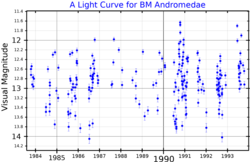Astronomy:BM Andromedae
| Observation data Equinox J2000.0]] (ICRS) | |
|---|---|
| Constellation | Andromeda |
| Right ascension | 23h 37m 38.49052s[2] |
| Declination | +48° 24′ 11.7624″[2] |
| Apparent magnitude (V) | 11.63 – 14.02[3] |
| Characteristics | |
| Spectral type | F8ea-K5Vea[3] |
| Apparent magnitude (B) | 12.40[4] |
| Apparent magnitude (V) | 12.40[5] |
| Apparent magnitude (G) | 12.76[2] |
| Apparent magnitude (J) | 10.524[6] |
| Apparent magnitude (H) | 9.523[6] |
| Apparent magnitude (K) | 8.810[6] |
| Variable type | T Tauri star[1] |
| Astrometry | |
| Radial velocity (Rv) | −12.37±3.96[2] km/s |
| Proper motion (μ) | RA: −5.249[2] mas/yr Dec.: +8.452[2] mas/yr |
| Parallax (π) | 1.2732 ± 0.6439[2] mas |
| Distance | approx. 3,000 ly (approx. 800 pc) |
| Details | |
| Luminosity (bolometric) | 5.5[7] L☉ |
| Other designations | |
2MASS J23373847+4824119, GSC 03642-00171 | |
| Database references | |
| SIMBAD | data |
BM Andromedae (BM And) is a T Tauri star in the constellation Andromeda. Its apparent visual magnitude has irregular variations between a maximum of 11.63 and a minimum of 14.02.[3]
Spectrum
The exact spectral class of the star is not yet known. Different estimations gives a range F8-K5Vea,[3] meaning that there is agreement in identifying it as a main sequence star more luminous and with stronger emission lines than the usual, a typical classification for young stars that are near the main sequence phase. The star is still accreting, and about 0.23 L☉ of 5.5 L☉ of its total luminosity is powered by accretion.[7]
The color indexes vary with the star's brightness, but the spectral class of BM Andromedae does not change with the decrease of luminosity. Strong H-alpha lines in the spectra are a sign of a gaseous envelope, while an infrared excess indicates the existence of an extended dust envelope.[1]
System
BM Andromedae is a young stellar object with a circumstellar cloud around it, one stage of the evolution from protostars to the main sequence phase. The cloud is made of a gaseous envelope and an extended dust envelope. The latter can reach a distance of 1 AU from the star and is strongly flattened and observed edge-on.[1] The measurements in 2005-2006 have showed a relatively compact, 0.25 AU disk.[7]
It was also found that a correlation exists between the local interstellar magnetic field and the polarization of light emitted by BM Andromedae. Thus, the magnetic field could have played a role in the formation of the system.[1]
Variability
In 1949 Balfour Whitney announced that BM Andromedae (at the time, an unnamed star) is a variable star, based on 400 photographic plates taken from 1942 through 1949. He noted that it varied rapidly and irregularly, sometimes varying by 1 magnitude over the course of a single day.[8]
The envelope blocks a fraction of the light emitted by BM Andromedae, but it's not uniform so this fraction is variable in time. This explains both the brightness variability and the one of color indexes. It was also found that the dust envelope polarizes the light emitted by BM Andromedae; the more light is blocked, the stronger is the polarization.[1] The color of star is dependent on brightness; it becomes redder when fainter.[9]
References
- ↑ 1.0 1.1 1.2 1.3 1.4 1.5 Grinin, V. P.; Kolotilov, E. A.; Rostopchina, A. (1995). "Dust around young stars. Photopolarimetric observations of the T Tauri star BM Andromedae.". Astronomy & Astrophysics Supplement Series 112: 457. Bibcode: 1995A&AS..112..457G.
- ↑ 2.0 2.1 2.2 2.3 2.4 2.5 2.6 Vallenari, A. et al. (2022). "Gaia Data Release 3. Summary of the content and survey properties". Astronomy & Astrophysics. doi:10.1051/0004-6361/202243940 Gaia DR3 record for this source at VizieR.
- ↑ 3.0 3.1 3.2 3.3 Samus, N. N. et al. (2004). "VizieR Online Data Catalog: Combined General Catalogue of Variable Stars (Samus+ 2004)". VizieR On-line Data Catalog: II/250. Originally Published in: 2004yCat.2250....0S 2250. Bibcode: 2004yCat.2250....0S.
- ↑ "BM And". SIMBAD. Centre de données astronomiques de Strasbourg. http://simbad.u-strasbg.fr/simbad/sim-basic?Ident=BM+And.
- ↑ Ducati, J. R. (2002). "Catalogue of Stellar Photometry in Johnson's 11-color system". CDS/ADC Collection of Electronic Catalogues 2237: 0. Bibcode: 2002yCat.2237....0D. VizieR database entry Accessed on line 2018-10-25.
- ↑ 6.0 6.1 6.2 Cutri, Roc M.; Skrutskie, Michael F.; Van Dyk, Schuyler D.; Beichman, Charles A.; Carpenter, John M.; Chester, Thomas; Cambresy, Laurent; Evans, Tracey E. et al. (2003). "VizieR Online Data Catalog: 2MASS All-Sky Catalog of Point Sources (Cutri+ 2003)". CDS/ADC Collection of Electronic Catalogues 2246: II/246. Bibcode: 2003yCat.2246....0C. http://vizier.u-strasbg.fr/viz-bin/VizieR?-source=II/246.
- ↑ 7.0 7.1 7.2 Eisner, J. A.; Hillenbrand, L. A.; White, R. J.; Bloom, J. S.; Akeson, R. L.; Blake, C. H. (2007). "Near-Infrared Interferometric, Spectroscopic, and Photometric Monitoring of T Tauri Inner Disks". The Astrophysical Journal 669 (2): 1072–1084. doi:10.1086/521874. Bibcode: 2007ApJ...669.1072E.
- ↑ Whitney, Balfour S. (May 1949). "A Reflection Nebula and an Associated Variable Star". Astrophysical Journal 109: 540. doi:10.1086/145162. Bibcode: 1949ApJ...109..540W. https://articles.adsabs.harvard.edu/pdf/1949ApJ...109..540W. Retrieved 31 March 2023.
- ↑ Siwak, M.; Dróżdż, M.; Gut, K.; Winiarski, M.; Ogloza, W.; Stachowski, G. (September 2019). "Mount Suhora High Cadence Photometric Survey of T Tauri-Type Stars". Acta Astronomica 69 (3): 227–260. doi:10.32023/0001-5237/69.3.2. Bibcode: 2019AcA....69..227S.
 |


